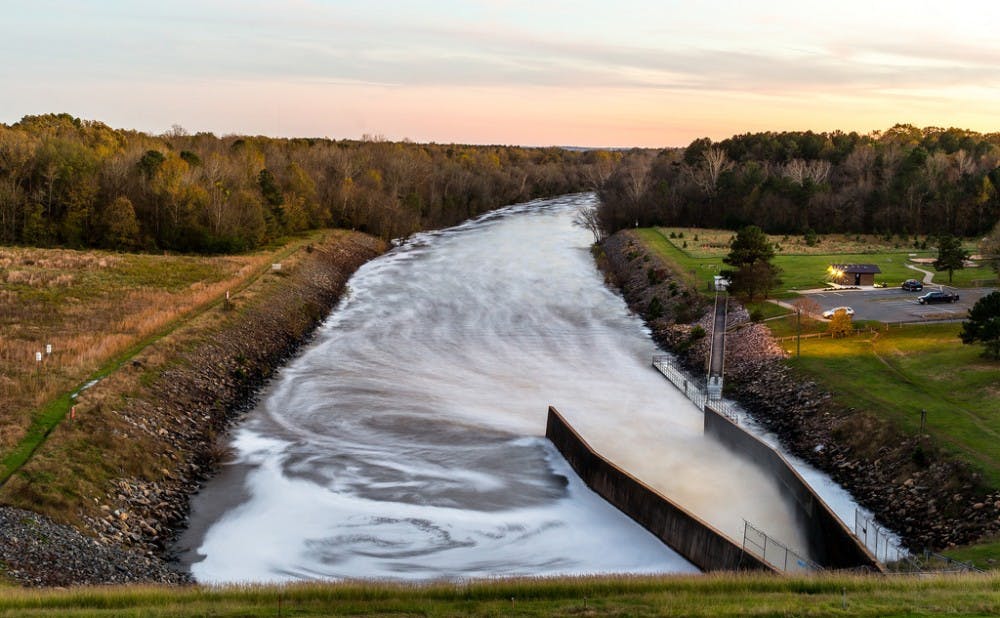Dams in North Carolina are not robust enough, and researchers are looking to fix the dam problem.
Since 2013, Duke researchers—Lauren Patterson, senior policy associate at the Nicholas Institute for Environmental Policy Solutions, and Martin Doyle, professor of river science and policy at the Nicholas School—have been working on a project investigating the target levels and management goals over time of dams and reservoirs built by the US Army Corps such as those in the Jordan and Fall rivers of North Carolina.
Dam strength is an issue during severe weather conditions, such as Hurricane Florence, which doubled the amount of stored water in both Jordan Lake and Falls Lake and caused major flooding in coastal areas.
"As Florence was coming, the reservoirs were on their target," Patterson said. "They did what they're supposed to do and delayed downstream releases so it would lower the downstream flooding going on."
However, despite the Army Corps infrastructure’s commendable performance during Florence, limitations to the reservoir infrastructure still made flooding possible, Patterson noted.
"[The infrastructure] is designed to last for a 100-year event or a 200-year event, but if you have an event bigger than that, it's not designed to hold that," she said. "[During Hurricane Florence], it rained a whole lot below the reservoir, so the reservoir [couldn't] have helped too much in mitigating flooding."
Reservoirs usually have a target level of water conservation, which varies from region to region and depends on the water supply, water quality and navigation, recreation.
The researchers gauge how Army water control plans meet their regular operation targets by measuring the effects of precipitation, temperature, population and water demand.
The target levels change according to different variables. For example, in dry summers, the elevation may be raised so the reservoir can hold more water since the risk of flooding is diminished and the water demand is higher, whereas during wet periods, the elevation may be lowered so there's more space available for flood control.
Striking a delicate balance between these two tasks of increasing and decreasing target water levels is difficult, especially during hurricanes such as Florence, which revealed the weaknesses of our water infrastructure.
North Carolina is also extremely flat, making it easier for floods to spread miles upon miles, Patterson added.
Despite the limitations to the reservoir infrastructure, it is not very likely to rebuild it—the best hope is to improve upon the original construction, she said.
"The cost to modify them, to raise the reservoir or get rid of a reservoir and build a new one is hundreds of millions of dollars," Patterson said. "So what they're looking at now is...how to modify reservoir operations to adjust to changing conditions."
For example, the local government in California uses forecasts to operate reservoirs differently according to the weather conditions. Therefore, when an extreme storm brings a huge amount of precipitation in a short period of time, the reservoir will be kept at a sufficiently low level, she noted.
Looking ahead with Hurricane Matthew, Patterson said the Army reservoirs will likely be more helpful as Matthew will bring more rain upstream and help mitigate downstream flooding.
But even so, Patterson added our water infrastructure will soon become unsustainable in preventing hurricane damage. As climate change worsens, more precipitation will be caught in the atmosphere, thereby increasing the likelihood for future high-intensity precipitation events like Florence.
And also, without proper management of flood planes and insurance, it is difficult to truly alleviate hurricane damage, she added.
“Don't build in flood planes and don't build in the coast,” Patterson said. “I think a lot of work could be done on how we manage our flood planes and enforce flood insurance and things like that.”
Correction: This article was updated Monday afternoon with Lauren Patterson's correct affiliation. The Chronicle regrets the error.
Get The Chronicle straight to your inbox
Signup for our weekly newsletter. Cancel at any time.

Mona Tong is a Trinity senior and director of diversity, equity and inclusion analytics for The Chronicle's 117th volume. She was previously news editor for Volume 116.

